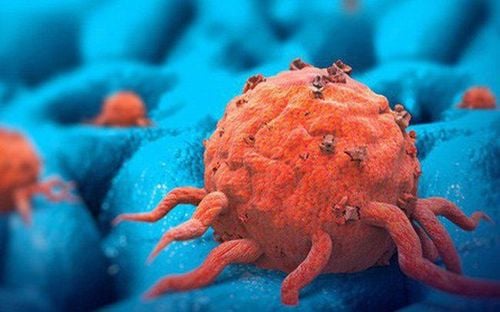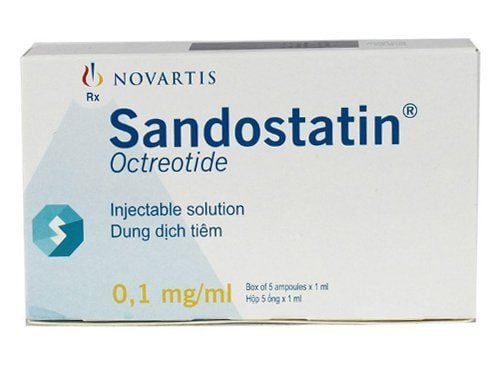This is an automatically translated article.
Telotristat is a Tryptophan hydroxylase inhibitor. This active ingredient is present in the drug Xermelo. So, what disease is Xermelo used for?
1. Uses of Xermelo
The active ingredient in Xermelo is Telotristat. Xermelo is used to treat diarrhea associated with carcinoid syndrome, seen in patients with carcinoid tumors or neuroendocrine tumors. These conditions cause the body to overproduce certain hormones, including serotonin, leading to symptoms known as "carcinoid syndrome". Overproduction of Serotonin leads to diarrhea. The active ingredient Telotristat in Xermelo is an inhibitor of the enzyme Tryptophan hydroxylase, thereby reducing serotonin production and secretion. Xermelo is often used in combination with another medicine called a somatostatin analog (such as Octreotide, Lanreotide).
2. How to use Xermelo (Telotristat)
Xermelo produced in tablet form, taken orally 3 times a day after meals. If the patient is co-administering short-acting octreotide, patients should take Xermelo 30 minutes prior to octreotide administration. If you accidentally miss a dose, skip it and just take your next dose at the usual scheduled time. Never take 2 doses at the same time to make up for the missed dose.
It is important for the patient to make sure to use Xermelo in the correct dose as recommended and directed by the doctor. Before each dose, the patient should check to see if the amount of medicine he is about to take matches the information prescribed by the doctor. Xermelo may interact with several other drugs, including: Clozapine, Hydrocodone, Nimodipine and CYP3A4 inducers such as Alprazolam, Amiodarone, Apixaban, Carbamazepine, Dexamethasone, Escitalopram, Itraconazole, Ketoconazole, Losartan, Oxyclimusone and Rivaroxaban odone. Patients should therefore be sure to provide their doctor with a list of all medications, vitamins and supplements they are taking before treating diarrhea with Xermelo.
3. Xermelo (Telotristat) side effects
There are several ways to control Xermelo side effects that can be used by patients, so talk to your doctor about this to find the best one. The following are some common or important side effects of Xermelo:
3.1. Xermelo causes constipation Xermelo medicine can cause constipation side effects, sometimes very serious. If constipation or abdominal pain persists or gets worse, stop taking Xermelo and contact your doctor promptly.
3.2. Nausea, vomiting Xermelo drug similar to other cancer treatment drugs can cause nausea and vomiting in patients. Patients should discuss with their treating physician to prescribe appropriate medications to control this side effect. In addition, patients can make the following changes to limit nausea and vomiting caused by Xermelo:
Adjust diet; Limit things/factors that can trigger or worsen vomiting, such as overeating, eating greasy/fatty, spicy or acidic foods (such as lemon, tomato, etc.) sour, orange); Use antacids or neutralize stomach acid to ease symptoms. 3.3. Headaches and fever The patient's treating physician may be able to recommend medications or other strategies to manage headaches during treatment with Xermelo. In addition, patients should quickly contact medical staff if the body temperature is 38 degrees Celsius or higher.
3.4. Reducing cravings A complete, scientific diet is an important part of the care and recovery process of cancer patients. However, current cancer therapies (such as Xermelo) can affect appetite and in rare cases can make it difficult to eat. Therefore, it is important for patients to discuss with their doctor about improving nutrition or choosing the right food. At the same time, the patient should apply some of the following measures:
Break down the day's meals into 5 or 6 small meals instead of just 3 main meals; If eating is not enough nutrition, the patient can consider supplementing with suitable products. Some patients taking Xermelo experience a metallic taste in their mouth or find food tasteless at all. This causes them to change their taste, no longer liking the food or drink that they liked before. This condition may persist for several months or longer after treatment with Xermelo is finished. To minimize the effects, patients should avoid foods with bad taste. If there is a problem with red meat, change to chicken, eggs, dairy products and fish that do not have a fishy smell. At the same time, you can add more flavor to the dish by marinating it with the right sauce.
3.5. Depression Xermelo can cause mood swings. If you frequently experience feelings of sadness, hopelessness, decreased interest and are unable to participate in daily activities because of a low mood, contact your treating physician for guidance.
3.6. Peripheral edema Peripheral edema is an uncommon side effect of Xermelo . This condition occurs due to increased water retention leading to swelling of the extremities, including the lower extremities (feet, legs, and ankles) or the hands. Patients should report any swelling to their oncologist.
3.7. Flatulence Xermelo may cause bloating, gas, belching, or heartburn. This effect can affect community relationships, making patients confused when communicating with others. You may need to use some over-the-counter medications available to relieve pain from gas and bloating.
Certain foods can aggravate bloating, so patients should keep a list of what they've eaten to help determine which causes bloating. Patients should talk to their doctor before starting any medication or if this side effect is bothersome.
4. Reproductive effects of Xermelo
Patients should consult their treating physician about the use of Xermelo before becoming pregnant, giving birth or breast-feeding.
Reference source: oncolink.org













